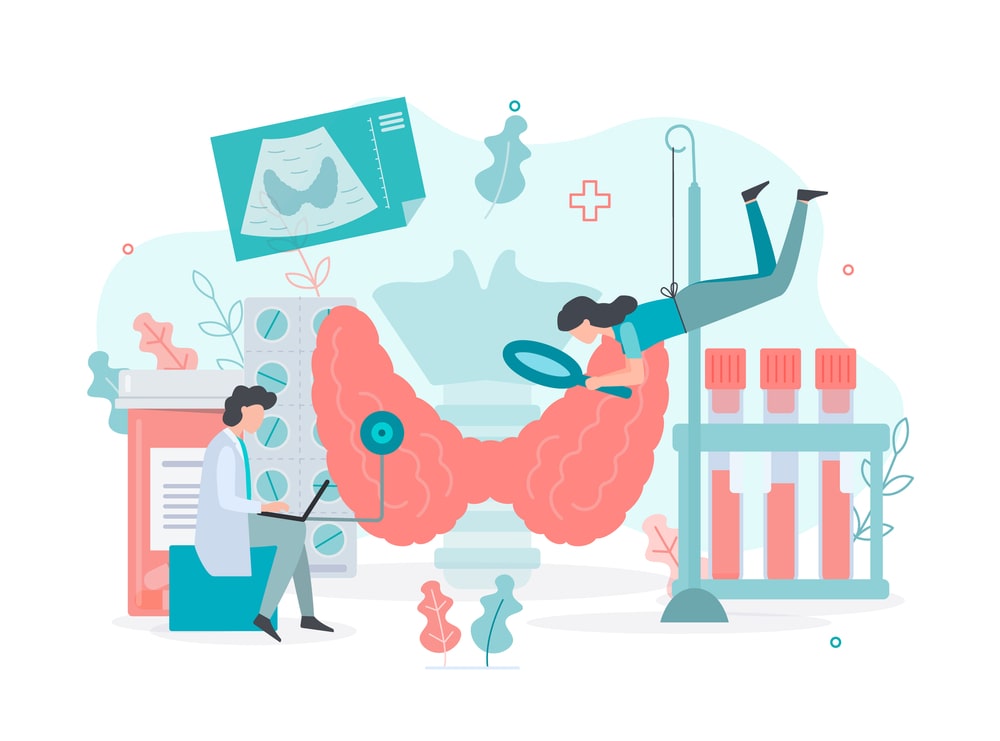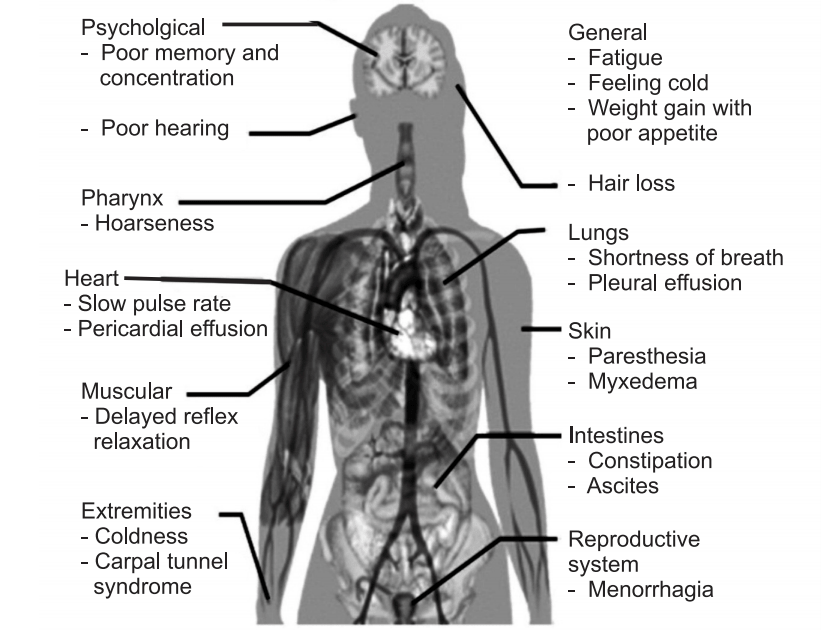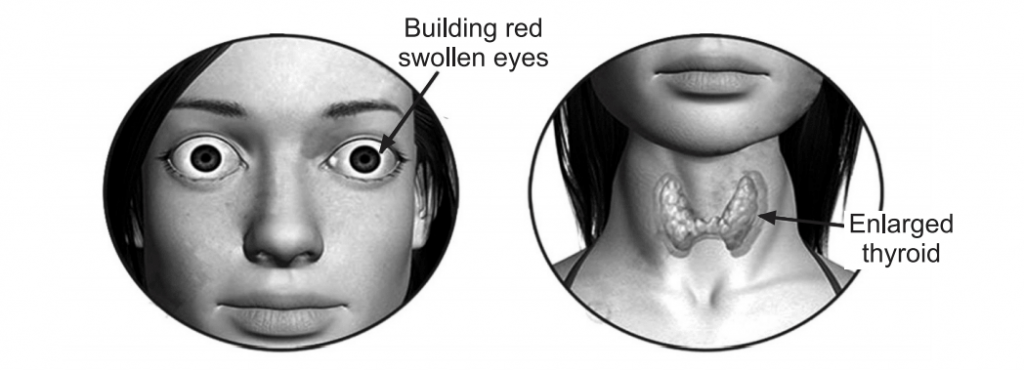Introduction of Thyroid Diseases:
Table of Contents
Thyroid is a small butterfly-shaped gland inside the neck, located in front of the trachea (windpipe) and below the larynx (voicebox). It produces two thyroid hormones, triiodothyronine (T3) and thyroxine (T4) that travel through the blood to all tissues of the body. Thyroid hormones regulate how the body breaks down food and either uses that energy immediately or stores it for the future. In other words, thyroid hormones regulate the body’s metabolism as well as the consumption of oxygen and the production of heat. Pituitary glands control how well the thyroid works by producing thyroid-stimulating hormone (TSH). The bloodstream carries TSH to the thyroid gland to produce more thyroid hormones, as needed.

Hypothyroidism:
Too little thyroid hormone from an underactive thyroid gland is called hypothyroidism. In hypothyroidism, the body’s metabolism is slowed. Several causes for this condition exist, most of which affect the thyroid gland directly, impairing its ability to make enough hormone. More rarely, there may be a pituitary gland tumor, which blocks the pituitary from producing TSH. Whether the problem is caused by the thyroid or by the pituitary gland, the result is that the thyroid is producing too few hormones, causing many physical and mental processes to become sluggish. The body consumes less oxygen and produces less body heat.
Symptoms of Hypothyroidism:
Symptoms of hypothyroidism can include:
- Fatigue,
- Poor concentration or feeling mentally “foggy”,
- Dry skin,
- Constipation,
- Feeling cold,
- Fluid retention,
- Muscle and joint aches,
- Depression,
- Prolonged or excessive menstrual bleeding in women.
Some common causes of hypothyroidism include:
- Hashimoto’s thyroiditis (an autoimmune condition that causes inflammation of the thyroid gland).
- Thyroid hormone resistance.
- Other types of thyroiditis (inflammation of the thyroid), such as acute thyroiditis and postpartum thyroiditis.

Hyperthyroidism:
Too much thyroid hormone from an overactive thyroid gland is called hyperthyroidism. This hormone imbalance occurs in about 1 % of all women, who get hyperthyroidism more often than men. One of the most common forms of hyperthyroidism is known as Graves’ disease. This autoimmune disorder tends to run in families. The thyroid gland is producing too much hormone in hyperthyroidism, the body develops an increased metabolic state, with many body systems developing abnormal function.
In mild cases, there may not be apparent symptoms. Symptoms and signs of hyperthyroidism can include:
- Tremor,
- Nervousness,
- Fast heart rate,
- Fatigue,
- Intolerance for heat,
- Increase in bowel movements,
- Increased sweating,
- Concentration problems,
- Unintentional weight loss,
Some of the most common causes of hyperthyroidism are:
- Graves’ disease,
- Toxic multinodular goiter,
- Thyroid nodules that overexpress thyroid hormone (known as “hot” nodules),
- Excessive iodine consumption.

Thyroiditis:
Thyroiditis is inflammation of the thyroid. It occurs when the body’s immune system makes antibodies that attack the thyroid. Causes of thyroiditis include:
- Autoimmune diseases like type I diabetes and rheumatoid arthritis,
- Genetics,
- Viral or bacterial infection,
- Certain types of medicines.
Two common types of thyroiditis are Postpartum thyroiditis and Hashimoto’s disease.
Postpartum thyroiditis:
It is inflammation of the thyroid after giving birth, affects 10% of women. It often goes undiagnosed because symptoms are much like the “baby blues” that may follow the delivery. Women with postpartum thyroiditis may feel very tired and moody.
Postpartum thyroiditis typically happens in two phases, though not everyone with the condition goes through both phases:
- The first phase starts 1 to 4 months after giving birth and typically lasts 1 to 2 months with signs and symptoms of hyperthyroidism because the damaged thyroid leaks thyroid hormones out into the bloodstream.
- The second phase starts about 4 to 8 months after delivery and lasts 6 to 12 months with signs and symptoms of hyperthyroidism because the thyroid has lost most of its hormones or because the immune attack is over and the thyroid may recover later.
Hashimoto’s disease:
Hashimoto’s disease is also known as chronic lymphocytic thyroiditis. It can occur at any age, but most common in middle-aged women. The disease occurs when the body’s immune system mistakenly attacks and slowly destroys the thyroid gland and its ability to produce hormones.
Some people with mild cases of Hashimoto’s disease may have no obvious symptoms. The disease can remain stable for years, and symptoms are often subtle and also not specific, which means they mimic symptoms of many other conditions.
- Fatigue,
- Depression,
- Constipation,
- Mild weight gain,
- Dry skin
- Dry, thinning hair,
- Pale, puffy face,
- Heavy and irregular menstruation,
- Intolerance to cold,
- Enlarged thyroid, or goiter.
Hashimoto’s diagnosis and treatment:
Testing the level of TSH is often the first step when screening for any type of thyroid disorder. It includes a blood test to check for increased levels of TSH as well as low levels of thyroid hormone (T3 or T4) if experiencing some of the above symptoms.
Hashimoto’s disease is an autoimmune disorder, so the blood test shows abnormal antibodies that might be attacking the thyroid.
Treatment:
There is no known cure for Hashimoto’s disease. Hormone-replacing medication is often used to raise thyroid hormone levels or lower TSH levels. It can also help relieve the symptoms of the disease. Surgery might be necessary to remove part or all of the thyroid gland is rare advanced cases of Hashimoto’s. The disease is usually detected at an early stage and remains stable for years because it progresses slowly.
Make sure you also check our other amazing Article on : Diabetes mellitus